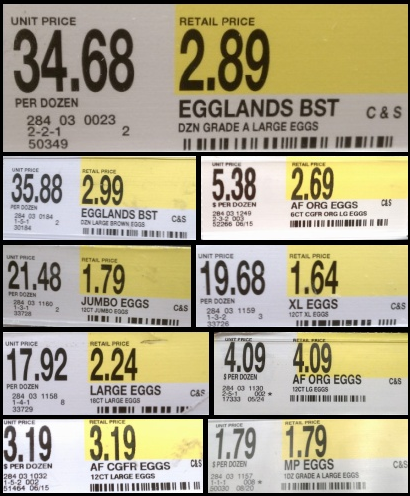Target’s Unit Pricing Looks Like a Bad Yolk on Consumers
I don’t often purchase dairy goods at Target. Today was an exception. Usually I head to Target for videos, office supplies, gift cards, Halloween decorations and so forth. On this occasion I needed some shipping boxes, birthday napkins and eggs. Rather than stop at two stores I decided to get the eggs at Target.
So why the posting? Well, either my math skills are getting really poor (probably due to my relentless exposure to computers and calculators) or Target has some issue with understanding egg pricing. Here are pictures of the price labels in the dairy section (taken at the Target in Clifton Park, NY on September 3, 2012). Anything look askew?
Now, if the errors were consistent I guess I could understand. After all converting from “12 eggs” to “price per dozen” takes some understanding of the word “dozen” along with the principle of unit pricing. What I find interesting is that the unit pricing calculation for these eggs is somewhat cracked since it does not seem to follow a pattern. Also, apparently no one has noticed these strange unit prices.
Unit pricing is supposed to help people make informed decisions about the price difference between options. It is irritating enough when the unit price for a “value” or “saver” size is higher than the regular size. But at least the shopper who is paying attention can readily identify the deception.
More troublesome is looking at a group of products and finding that their unit prices don’t use a consistent unit. For example, I’ve looked at cereals and had some brands give a unit price per ounce and others per pound. Worse, I’ve seen volume and weight measures used on similar products. Clearly such a store doesn’t want me (the consumer) to have an easy path to understanding the relative prices of those items.
In this case the unit price is just plain wrong. It cannot be used in any way to compare the relative prices of the eggs since the error isn’t consistent, creating some sort of shell game. In several cases the unit price is correct, in others it is off by 12 (treating the price for 12 eggs as if it were the price for 1). In one case the error is a factor of 8. Where did they come up with 8?
Being both amused and frustrated by these errors, I’ll be taking a closer look at unit pricing at a variety of stores just to understand the reliability of these “consumer aids.” It will be interesting to compare the results between retail chains as well.
Anyone out there ever use unit price information when choosing which product to buy? Ever found errors or confusing unit pricing schemes being used?
Tags: consumer awareness, linkedin, unit pricing
